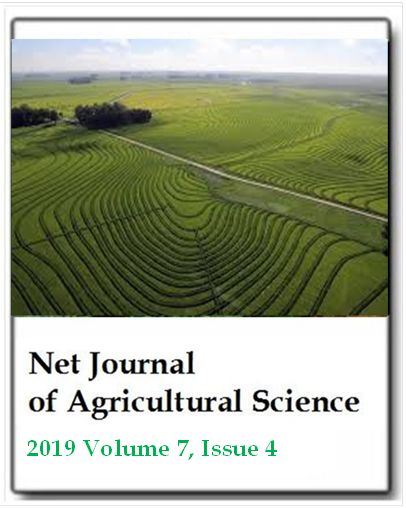Adoption and impact of improved cassava (Manihot esculenta Grantz) production technology on farmers’ welfare in Mezam Division of the North West Region of Cameroon
Tatiana Chi Zie, Ibrahim Nformi Manu and Herve Alain Napi WouapiNet Journal of Agricultural Science
Published: November 22 2019
Volume 7, Issue 4
Pages 112-124
DOI: https://doi.org/10.30918/NJAS.74.19.032
EXECUTIVE SUMMARY
This research sample, one of a series of adoption case studies championed by the ongoing Programme for the Improvement of Competitiveness of Family Agro-pastoral farms, examines the adoption by Mezam farmers of improved cassava production technologies (ICPT) diffused through ACEFA programme. The latter is a programme jointly managed by the French government and the Cameroon government (through the ministry of Agriculture and Rural Development - MINADER and the ministry of Livestock, Fishery and Animal industries - MINEPIA) to support Family Agropastoral Farm enterprises (FAFs) in Cameroon as to what concerns supportive counseling and financing in the form of investments. This research work was carried out during the second phase of ACEFA’s programme which started in 2012 and ran up to 31st of September 2018, and has progressively covered the 58 Divisions that make up the 10 Regions of Cameroon. The objective of the evaluation was to assess the success of adoption and impact of improved cassava production technology (ICPT) at the farm level, and by implication the success of ACEFA’s programme in facilitating the transfer of those technologies. The evaluation design combines elements of theory-based and case-based approaches. These stem from a realist perspective; that is, a recognition that outcomes are affected positively and negatively by the real world context in which they occur. Realist evaluation recognizes the complexity of interventions in the social world and the difficulty of isolating the impact of a single intervention, seeking instead to explore what works, for whom, in what circumstances and why. In line with realist, theory-based approaches, the evaluation methodology tested an ex-post theory of change (TOC) developed with ACEFA. The evaluation used mixed qualitative and quantitative methods, combining desk-based secondary data with field-based primary data collection and analysis. The evaluation methodology for primary data collection on the adoption of ICPT was done through a survey of cassava growers conducted between January and July 2018. A four-stage, clustered, randomized procedure was used to select a representative sample of 180 cassava farmers. These farmers were administered semi-structured questionnaires about their cassava production, consumption, marketing practices, preferences for different cassava cultivar characteristics, and their knowledge of, and access to improved seed and fertilizer. Data were analyzed using SPSS and the quasi-experimental method.
The survey revealed that adoption of improved cassava production technology has been extensive. Close to two-third of the farmers (63.90 %) planted improved cassava variety (ICV) on their cassava fields with most cultivated variety being 96/1414 (66.1%). A similar proportion (62.2%) practices the planting configuration techniques. Socio-economic analysis results showed that majority of the farmers were females (65.56%) and over 46 years of age with over 4 members per household. Majority of the respondents were married (75 %) having primary level of education (66.1%). Most of the respondents reported not to be novice in cassava production. Majority of respondents (67.8%) own the land they use for production. However, the rate of fertilizer use on cassava was relatively low as less than one-third of sample farmers (30.60%) reported having applied fertilizers in their cassava fields. Adoption rates were higher among female farmers than male farmers, and 77.39% of the respondents revealed that they adopted because the variety is high yielding and profitable. 55.38% of those who did not adopt revealed that disadoption is influenced by the degree of availability and accessibility of local cuttings compared to improved cuttings.
What have been the impacts of the ICPT?
In the absence of reliable baseline data, it was not possible to calculate quantitative measures of project impact. Based on farmers’ qualitative judgments, however, it is clear that adoption of ICPT has been associated with significant farm-level productivity gains (cassava yields after adoption: 9084.10 kg) and noticeable increases in the income earned (87.78%) from sales of cassava (76.67%). 63.30% of the respondents experience an increase in their consumption. Furthermore, harnessing on social capital and access to counseling the farmers have been able to improve on their associative life while gaining new skills. Also, impacts on the nutritional status of rural households appear to have been improved. Results from focus group discussion revealed that the average number of meals per day had changed since the adoption of ICPT, and the frequency of “luxury food” consumption (meat and/or fish) had increased from one to two or three times per week.
In addition to documenting the uptake and diffusion of ICPT, this case study provides valuable insights about the many factors that can affect the adoption of agricultural innovations in general. The survey results show that adoption of improved cassava production technology is directly influenced by three sets of factors: (i) characteristics of the technology (e.g. complexity, profitability, riskiness, compatibility with other technologies); (ii) characteristics of the farming systems (e.g. agro-climatic conditions, prevailing cropping systems, access to credit, age and farm size, and availability of physical inputs); and (iii) characteristics of the farmer (e.g. ethnicity and culture, wealth, education, gender). Most challenges faced in production were poor road infrastructure (47.8 percent) and fast decay of tubers (43.9 percent), which call for getting down decentralized rural infrastructures along with quality and efficiency of related services. For instance, storage facilities will require roads and transport services to get crops to collection points as well as reliable energy services to keep perishables in proper condition.
Keywords: Rate of adoption, impact, technology, cassava producers, logit model.
Full Text PDF
ISSN: 2315-9766
